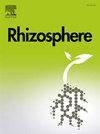Mucilage increases soil resistance to penetration after compaction
IF 3.4
3区 生物学
Q1 PLANT SCIENCES
引用次数: 0
Abstract
Mucilage offers several beneficial functions for soils, yet its impact on soil mechanical behavior remains underexplored. This study investigated the effects of chia seed mucilage on the plasticity index (under normal conditions) and penetration resistance (under compaction) of sandy clay loam soils with differing soil organic carbon (SOC) levels from Akhtar Abad (SOC = 1.6%) and Najm Abad (SOC = 0.6%) in northern Iran. Four mucilage concentrations (0, 1 g kg⁻1, 3 g kg⁻1, 5 g kg⁻1) and three compaction pressures (100 kPa, 300 kPa, 600 kPa) were used. We found that mucilage significantly increased the plasticity index, with a 5.8% increase at 1 g kg⁻1 in the Najm Abad soil and 2.6%–3% increases at higher concentrations in the Akhtar Abad soil. At a concentration of 3 g kg⁻1, soil penetration resistance in the Akhtar Abad soil increased by 0.9 MPa and 1.6 MPa at compaction pressures of 300 kPa and 600 kPa, respectively. In the Najm Abad soil, a concentration of 5 g kg⁻1 led to increases of 0.7 MPa and 1.7 MPa at compaction pressures of 300 kPa and 600 kPa, respectively. No significant relationship was found between soil penetration resistance and soil plasticity index. The mucilage-induced increase in soil plasticity may hinder soil workability, especially when tillage occurs immediately after crop harvest. Mucilage can also increase soil resistance to root penetration in areas compacted by heavy machinery. To mitigate these risks, we recommend performing tillage and machinery operations in both agricultural and forest ecosystems during dry periods, when mucilage is less active, to minimize its negative impact on soil workability and compaction.
求助全文
约1分钟内获得全文
求助全文
来源期刊

Rhizosphere
Agricultural and Biological Sciences-Agronomy and Crop Science
CiteScore
5.70
自引率
8.10%
发文量
155
审稿时长
29 days
期刊介绍:
Rhizosphere aims to advance the frontier of our understanding of plant-soil interactions. Rhizosphere is a multidisciplinary journal that publishes research on the interactions between plant roots, soil organisms, nutrients, and water. Except carbon fixation by photosynthesis, plants obtain all other elements primarily from soil through roots.
We are beginning to understand how communications at the rhizosphere, with soil organisms and other plant species, affect root exudates and nutrient uptake. This rapidly evolving subject utilizes molecular biology and genomic tools, food web or community structure manipulations, high performance liquid chromatography, isotopic analysis, diverse spectroscopic analytics, tomography and other microscopy, complex statistical and modeling tools.
 求助内容:
求助内容: 应助结果提醒方式:
应助结果提醒方式:


